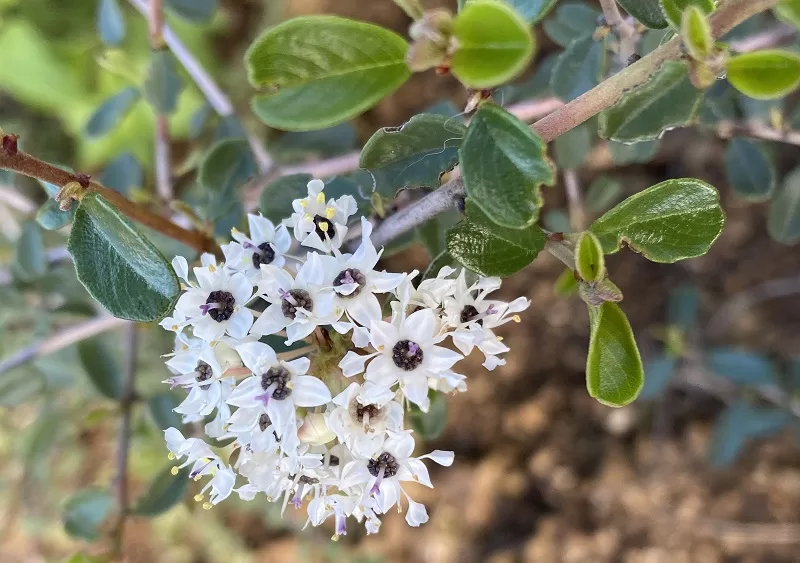All over the Santa Monica Mountains, big pod ceanothus is blooming. In a good year, the clusters of small, honey-scented white flowers are so abundant they resemble a dusting of snow on the canyon walls, and this is a good year. This is a keystone plant in the local chaparral ecosystem. For Topangans, the white flowers—sometimes called “California lilac”— are a time-honored harbinger of spring. Big pod—Ceanothus megacarpus—blooms soon after the first significant rains, often long before any other spring flowers, including other members of the same family. In the Woolsey Fire burn zone, the big pod ceanothus has been almost completely absent for the past five years. It is blooming again for the first time since the fire swept through half of the Santa Monica Mountains in 2018.

Unlike some of the other members of this plant family, big pod ceanothus cannot re-sprout from its roots after a fire. Mature plants are completely destroyed by the heat. However, the seeds stored in the pods that give this plant its common name, have evolved a mechanism for survival in wildfire country. The fire activates the seeds, speeding their germination. Provided another fire doesn’t occur too soon, the new seedlings will quickly grow to maturity, taking advantage of the sunlight and nutrients in the fire-scoured landscape.
This flower is not only a harbinger of spring this year, but a manifestation of hope, a hope that continues to sustain the communities that are still working, one step at a time, to put the fire behind them.
Creeks are still running but the Santa Monica Mountains are already drying out, after an impressive series of winter storms that dropped as much as 17 inches of rain on some areas. Topanga had its share of mudslides, falling boulders and road closures during the storms, but it’s important to remember that rock slides can also happen after the storms are over, as saturated soils shift. It’s a good idea to use extra caution on the roads and watch for rocks and debris, even when it isn’t actively raining.
Most of the Santa Monica Mountains National Recreation Area storm closures have reopened—there are exceptions like Rocky Oaks, which is still drying out—but the National Park Service is cautioning that some trails have been heavily damaged by the rain and are not accessible. They are asking park users to respect closures, exercise caution and plan ahead.
Many of us are still mopping up from a soggy start to the new year, but we had a jarring reminder that wildfire is still a hazard, even in the middle of the wettest rainy season in years. A fire broke out on Pacific Coast Highway near Tuna Canyon on January 21, and quickly spread in steep terrain. The blaze was rapidly contained thanks to immediate response from firefighting aircraft using the water resources at Topanga’s own helistop 69 Bravo. The incident was a warning that fires can occur at any time regardless of the weather, and an impressive demonstration of the effectiveness of the county’s state-of-the-art aerial firefighting program. We have the details in our Newsbeat section.

We also have a TNT exclusive news story in this issue. Our Discover section reveals a surprising discovery: the first appearance in many decades of what appears to be the remnant of a railroad bridge built between 1905-1908 for the legendary Hueneme, Malibu, Port Los Angeles Railway—Malibu’s ghost train.
Clear skies are in the forecast for the next week, and that is good news for skywatchers hoping to catch a glimpse of another recent discovery: comet C/2022 E3 (ZTF). This long-distance traveler’s last visit to our part of the solar system was 50,000 years ago. The comet will probably remain too dim to be seen with the naked eye but it should be visible with the help of a pair of ordinary binoculars and a little patience. The best opportunity will be in the predawn hours on the mornings of January 31 through February 2. The comet is currently passing between Ursa Major and Minor (aka, the Big and Little Dippers), just to the left of the constellation Cassiopeia, in the northeastern part of the sky.
The dramatic photos of the vivid green comet (colored by diatomic carbon released as it approaches the sun) are the product of powerful telescopes, but it’s still worth a look. Light pollution and moon light will make this comet challenging to view in all but the darkest dark sky areas, but this really is a once in a lifetime opportunity. It may be a million years before this comet passes our way again.
Stay safe, be well.













